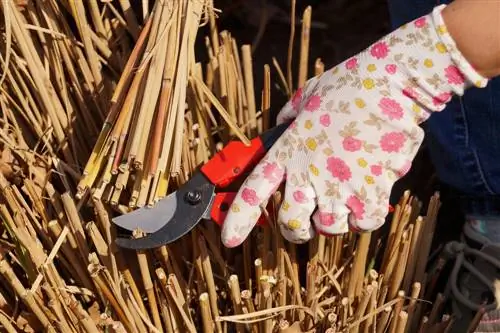- Author admin [email protected].
- Public 2023-12-16 16:46.
- Last modified 2025-01-23 11:22.
The species miscanthus and giant miscanthus usually fall under the name elephant grass. The same procedures apply when it comes to cutting for both ornamental grasses. If this is done regularly, nothing stands in the way of he althy growth.

When and how should elephant grass be cut?
Elephant grass should be cut in spring, preferably in April, when no young shoots can be seen yet. A radical cut back to 8-12 cm above the ground promotes he althy growth, while occasional maintenance pruning may be necessary in cases of illness or growth problems.
Time
In autumn, the grass draws its energy from the leaves and deposits the assimilates into the underground root system. Pruning measures are not recommended before winter, as moisture can then accumulate in the open stalks and cause rot. At the same time, the eyrie becomes more vulnerable to cold temperatures because the protective blades of grass are missing from the earth's surface.
Spring cut
The ideal period extends from the end of winter until the fresh shoots sprout. China grass is one of the species that sprouts relatively late. Therefore, cuts are recommended in April when no young shoots can be seen and the metabolism is slowly getting going.
Preparations
Before you reach for the scissors, some preparatory measures are necessary. These are necessary from a nature conservation perspective and make your work easier.
Control
Many insects and small mammals, including hedgehogs, mice, ladybirds and lacewings, use the dead grass clumps as overwintering quarters. Postpone cutting measures if you encounter sleeping guests.
Binding material
You can make cutting more convenient with ribbons (€6.00 on Amazon). Tying them together is particularly recommended for clumps that have expanded significantly in width. Such specimens are gathered into several bunches and tied together. After the subsequent cut, the bundles can be removed more easily without individual blades of grass flying around in the garden.
Cutting techniques
There are two possible cutting measures for this ornamental grass. In general, radical pruning is carried out every year so that the fresh stalks receive enough light and air for he althy growth.
Radical cut
If spring has been particularly mild so that young shoots appear at the time of cutting, these must not be cut off. Only shorten the dried stalks to such an extent that you do not damage the fresh shoots. If the clump is already heavily overgrown with young stalks, only remove the outer stalks from the previous year.
Basic procedure:
- Cut Horst to a hand's width above the ground
- ideal is a remaining height of eight to twelve centimeters
- Run the knife vertically through the individual tufts
care cut
Occasionally a he alth cut is necessary if the elephant grass has diseases or growth problems. If the grass is affected by rot, the affected blades must be generously removed and cut off directly above the ground. Expose the base of the stalk so that it can dry and no moisture from the substrate penetrates into the open interfaces.
Share
Immediately after pruning is the ideal time to divide the miscanthus. Use the spade to cut off sections that have at least three to four shoots. Get them out of the ground and plant the clumps in the desired location.






